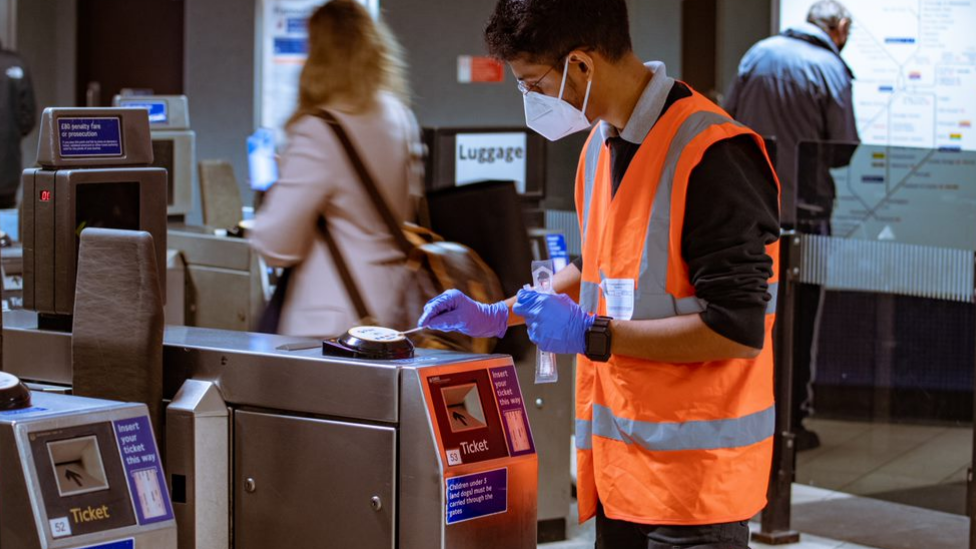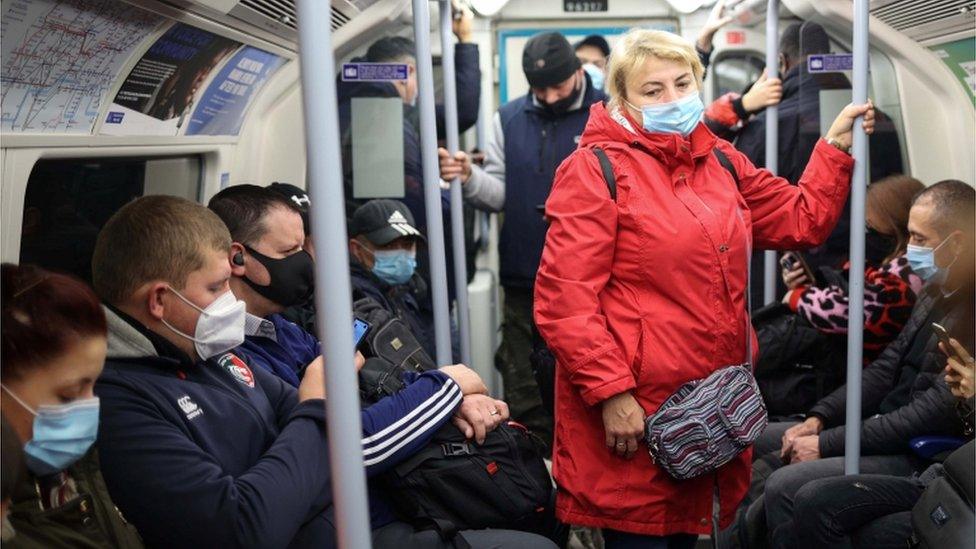No Covid variants found on London Tubes, buses and stations
- Published
- comments

Monthly tests have found no traces of coronavirus, including new variants, in air samples and swabs of London's Tube trains, buses and stations.
But this does not mean none is circulating or commuters can let down their guard, the researchers, at Imperial College London, say.
There has been extra cleaning through the pandemic, to combat spread from contaminated surfaces and breath.
But commuters should continue to wear face coverings.
Imperial College London is testing for coronavirus on London's transport network
Every month, since October, the researchers swab heavily touched areas, such as ticket barriers, stop buttons on buses, rails and handles on Tube trains and escalator handrails, from:
two Tube stations
one Tube line
one Tube train
one bus depot
one bus journey
And a machine that draws in about 300 litres (66 gallons) of air per minute checks for airborne virus.
The samples are sent the same day to Prof Wendy Barclay's lab, external so her team can study the genetic make-up of any coronavirus to detect any of the variants found elsewhere in the UK.
Having undergone changes to their spike protein, the part of the virus that attaches to human cells, these seem to be better at infecting cells and spreading.
And they may be mutating in ways that could make vaccines less effective against them.
There is no evidence they cause much more serious illness for the vast majority infected.
As with the original version, the risk is highest for people who are elderly or have significant underlying health conditions.
But some research suggests the new variant identified in the UK may be associated with a 30% higher risk of death.
And the government has stepped up screening in areas where variants have been found, offering people door-to-door tests.
But the work by the team at Imperial suggests even with new variants circulating in the UK, the risk of infection can be mitigated.
Dr David Green, senior research fellow at Imperial, said: "During the early stage of the pandemic, everybody was very concerned about washing their hands and touching surfaces.
"As we've moved on, we are much more convinced that the routes of transmission tend to be through the air - through breathing, through being in confined environments, not maintaining social distancing or not wearing masks.
"If you think about the London Underground environment and other transport networks, they are being cleaned very regularly and very thoroughly at the moment.
"The occupancy level is much lower.
"And everybody is wearing masks.
"All of these things will reduce the chances of the virus being spread in these environments.
"Once a month, we do a journey that we feel reflects the type of journey that a commuter would take.
"So we travel from one Tube station to another.
"And we get on a bus and travel.
"We tend to do the same route every month.
"So we get an idea of how things change over time, rather than try a scattergun approach across the entire network.
"All of the results have been negative so far, which is very reassuring for everybody travelling.
"But if we did get a positive result, then we could do further investigations into which particular variant it was."

LOOK-UP TOOL: How many cases in your area?
SOCIAL DISTANCING: How can I meet my friend safely?
FACE MASKS: When do I need to wear one?
THE R NUMBER: What it means and why it matters
DELIVERIES: How can I get a takeaway safely?

Related topics
- Published3 November 2020

- Published16 February 2021

- Published1 July 2022
